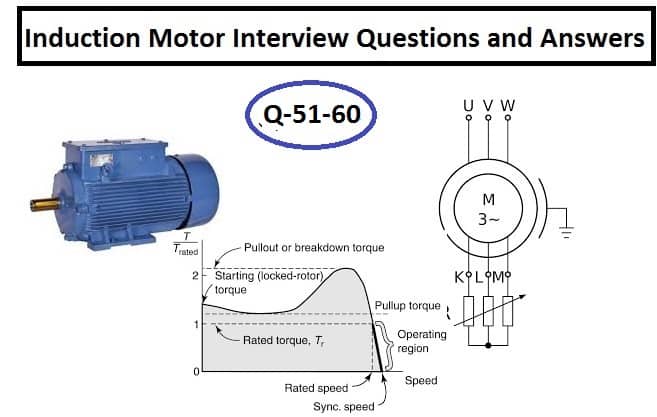
Q.51 What is the major disadvantage of the star-delta starting of induction motor?
In a star-delta starter, the stator first gets connected to the star. In a star, the voltage per phase is VL/√3. Where VL is the line voltage. The torque produced by the motor depends on the voltage & it is the square of the voltage.
T ∝ V2
T ∝ (V/√3)2
T ∝1/3
Thus the torque delivery of the motor gets reduced by 66 % of the full load torque capacity of the motor.
Q. 52 Why exciting current of the induction motor is more as compared to the transformer?
The transformer and induction motor both function of electromagnetic induction. The electrical energy first converts into magnetic energy. The magnetic energy flow through the core and then flux links to the rotor. The reluctance offered to magnetic flux depends on the air gap length and it is inversely proportional to the air gap length.
In an induction motor, there is an air gap and it offers high reluctance in comparison to the transformer which has no air gap. This is the reason the induction motor draws a large exciting current compared to the exciting current of the transformer.
Q. 53 What are the slip rings?
The slip rings are made of copper alloys and are fixed around the shaft insulating it. These slip rings and brushes connect the rotor winding to the external resistance circuit.
Q. 54 Why resistance is added to the rotor winding in the slip ring induction motor?
The starting torque delivering capacity can be increased by connecting the external resistance to the rotor winding. The rotor resistance is gradually reduced as the motor accelerates towards its base speed and finally the rotor winding gets a short circuit through the final shorting contactor. Now, the motor functions as a squirrel cage induction motor.
Q. 55 What are the different types of duty classes of induction motor?
Different types of duty classes are as follows.
- S1 duty Continues duty
- S2 duty short time duty
- S3 Intermittent duty
- S4 Intermittent periodic duty with starting
- S5 Intermittent periodic duty with starting and braking
- S6 Continues duty with periodic Intermittent duty
- S7 Continues duty with starting and braking
- S8 Continues duty with periodic speed changes
Q. 56 What are the different temperature classes of motor insulation?
Different insulation classes:
| Class | Temperature (deg) |
| Y | 90 |
| A | 105 |
| E | 120 |
| B | 130 |
| F | 155 |
| H | 180 |
| C | >180 |
Q. 57 What is rotor skewing?
The rotor of the squirrel cage induction motor is skewed by some angle so that the bars lie under alternate harmonic poles of the same polarity or other words, bars must be skewed through two pitches. The main purpose of skewing is to reduce the magnetic logging between the starter and the rotor.
Q. 58 An 4-pole, 3-phase, 50 Hz induction motor is operating at a speed of 1470 rpm. What is the rotor frequency in Hz?
Synchronous speed of the motor (Ns)= 120f/P =120 x 50/4 = 1500 RPM
slip = (Ns-N)/Ns = (1500-1470)/1500 = 30/1500 = 0.02
Rotor frequency = slip X stator frequency
fr = 0.02 x 50 = 1 Hz
Q. 59 The basic operation of an induction motor is based on which principle?
The induction motor and transformer both work on the mutual induction principle. Faraday’s Law of electromagnetic induction is the basic principle on which induction motor functions.
Q. 60 If a 4-pole 50 Hz 3-phase induction motor run at 1480 rpm, then value of slip is
Synchronous speed of the motor (Ns)= 120f/P =120 x 50/4 = 1500 RPM
Actual speed of motor, N= 1470
% slip = (Ns-N)/Ns X 100 = (1500-1480)/1500 X 100 =20/1500 X 100 =1.33 %
% slip = 1.33 %
Awesome content. please continue this series.
Regards.